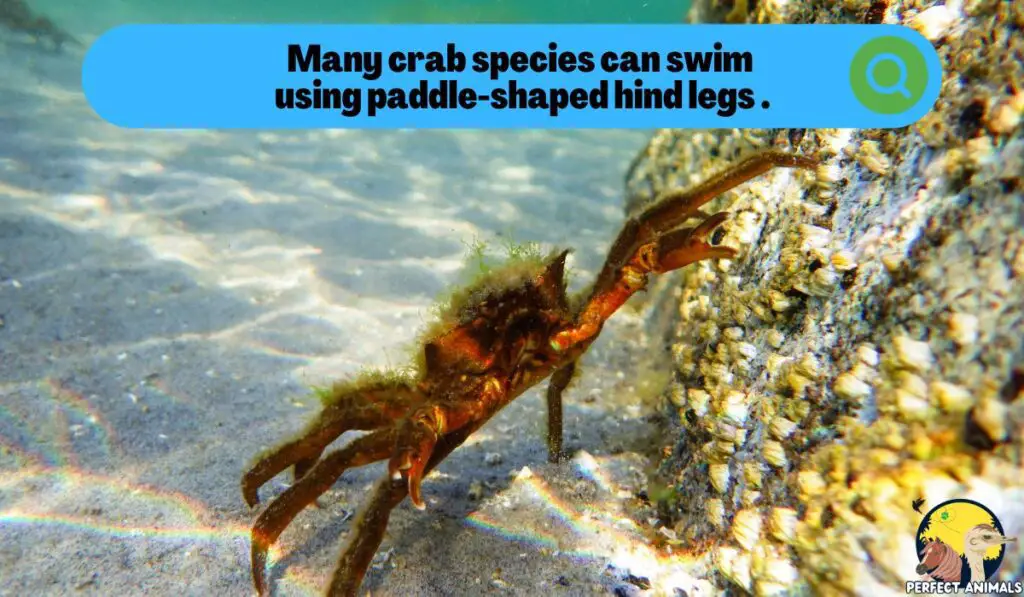Crabs are fascinating creatures that inhabit beaches, tidal pools, and oceans worldwide.
With their sideways scuttle and formidable pincers, they seem built for scavenging along sandy or rocky bottoms.
But can crabs swim? The answer is yes—while not all crab species can swim, many crabs are quite capable in the water.
In this article, we’ll explore the swimming abilities of various crab species.
We’ll look at how crabs swim, how long, and how fast they can swim.
We’ll also answer questions like whether crabs can walk underwater if they can survive being submerged, and why horseshoe crabs swim upside down.
Finally, we’ll discuss crabs that can’t swim at all. Let’s dive in and take a closer look at whether crabs can swim!
Can Crabs Swim?
Crabs are capable of swimming. While not all crab species are able to swim, many crabs are quite adept at underwater movement.

Crabs have specially adapted paddle-like rear legs that allow them to effectively propel themselves through the water.
Their legs are designed to push back against the water, providing thrust.
This allows crabs to not just walk along the seafloor, but also swim up off the bottom for distances.
Some species like blue crabs and fiddler crabs are very strong swimmers.
They can stay suspended in the water column for lengthy periods of time and cover significant distances with their swimming.
Other crab species may not be able to swim continuously for as far, but can still swim in short bursts to escape predators or move to new locations.
You May Also Like – How Many Eyes Does An Octopus Have?
How Do Crabs Swim?
As mentioned above, crabs are able to swim using their specially adapted rear legs.
Crabs swim by pushing water backward using a paddling motion with their back legs.
Their rear legs are shaped like paddles or flippers, which provide surface area to push against the water. As a crab swims, it alternately moves its left and right back legs in a walking or paddling motion.
This creates a forward thrust to push the crab through the water.
The paddle-shaped hind legs provide significant surface area for the crab to push against the water.
Crabs can modify the angle and position of their leg paddles to provide power and steering while swimming.
Some crabs may also use their smaller front claws and legs to help steer and stabilize them while swimming.
Crabs don’t just rely on leg paddling to swim.
Some species are also able to contract muscles in their shell to forcibly expel water, providing jet propulsion to shoot backward through the water.
This can help them make quick escapes from predators.
You May Also Like – Do Pufferfish Have Teeth?
How Long Can Crabs Swim?
Crabs can swim for varying amounts of time depending on the species.
Some crabs are able to swim continuously for quite long distances, while others may only be able to swim in short bursts.
Species like the Atlantic blue crab have high endurance and can swim for extended periods. They use this ability to migrate between estuaries and the open ocean over thousands of miles.
Other good swimmers include fiddler crabs, spider crabs, and hairy crabs, which can remain swimming for dozens of minutes or longer without needing to rest on the seafloor.
On the other hand, crabs like rock crabs and king crabs have lower stamina for continuous swimming. They may only be able to swim for a few minutes at a time before needing to pause their swimming and walk along the bottom.
Their swimming is usually only in quick bursts to escape predators or briefly move to a new location.
The duration a crab can swim also depends on factors like temperature and molting state.
Colder water temperatures and approaching a molt can shorten their swimming time.
But in optimal conditions, some athletic crab species have remarkable swimming endurance and can keep moving through the water for substantial distances without tiring.
Their specialized adaptations allow them to swim for as long as needed to migrate, find food, or escape danger.
You May Also Like – Do Barracudas Eat Fish Eggs?
How Fast Can Crabs Swim?
The maximum swimming speed of crabs varies between different species. Some crabs are quite speedy underwater, while others move along at a more leisurely pace.
Fast-swimming crabs like blue crabs can reach speeds of up to 3 miles per hour as they paddle swiftly through the water.
Their powerful rear swimming legs allow them to cruise along at a good clip. Fiddler crabs are also speedy, clocking around 2 miles per hour when swimming.
Other crab species have slower maximum swimming speeds. King crabs and snow crabs, for example, tend to lumber along at around 1 mile per hour or less.
Their swimming is not designed for speed, but rather short bursts to get them to the seafloor or away from predators.
A key factor for crab swimming speed is how quickly they can move their paddle-like hind legs.
Fast swimmers like blue crabs can rapidly oscillate their rear leg paddles at 20-40 cycles per minute.
This quick leg motion propels them rapidly through the water. Slower crabs may only paddle along at 10 cycles per minute or fewer.
So while no crabs are breaking any speed records compared to fish, some are quite impressive swimmers able to cover ground at a fast clip.
With their strong, specialized swimming legs adapted for power and speed, crabs like the blue crab can genuinely zip along at a quick pace in short bursts.
Related Article – Do Sea Turtles Drink Water?
Do Crabs Walk in Water?
While crabs are capable swimmers, they actually spend much of their time walking along the seafloor.
Their legs are adapted for walking and grasping onto surfaces.
Crabs are equipped with pointed walking legs with gripping tips that allow them to get traction on rocky, sandy, and muddy bottoms.
They can use these legs to walk, crawl, and climb across all kinds of surfaces on the ocean floor.
Some species even have legs specifically for grasping onto sea grass and other aquatic vegetation.
A crab’s walking legs move in a paddling motion similar to how they swim.
But when walking underwater, only their rear paddle legs move while their front legs grip the ground.
This propels them across the seafloor. Crabs can cover ground more efficiently by walking than swimming.
Crabs may choose to walk rather than swim for a few key reasons.
Walking allows them to search along the bottom and find food more effectively.
It is also less tiring for crabs to walk short distances than constantly swim.
Additionally, walking gives them secure footing if they need to fight or flee from predators.
You May Also Like – Do Fish Blink? Fact or Fiction?
Can Crabs Survive Underwater?
Yes, crabs are well adapted to surviving underwater for extended periods of time.
This is because crabs have specialized gills that allow them to breathe oxygen from the water while submerged.
A crab’s gills are feather-like structures located inside chambers in their body.
As water flows through the chambers, fine hairs on the gills extract the dissolved oxygen and transport it into the crab’s bloodstream.
This process allows a crab to breathe normally while fully underwater, just like fish.
However, not all crabs can remain submerged indefinitely. Some species like land crabs have gills suited for moist air but less efficient in water.
They need to periodically surface to get more oxygen.
Other crabs like blue crabs and rock crabs have robust gills tailored for aquatic life, allowing them to stay underwater as long as needed.
While a crab’s gills work underwater, they must stay moist when out of the water.
A crab out of water for over 24 hours can survive if in a humid area or if they moisten their gills by frequently damping them.
This keeps their gills working to get oxygen until they can return to the water.
So with their specialized gill structures, crabs are well equipped to breathe and survive for extensive periods of time while fully submerged underwater, as long as they are a species with water-suited gills.
This adaptability allows them to thrive in their aquatic domains.
You May Also Like – Can Sharks See in the Dark?
Why Do Horseshoe Crabs Swim Upside Down?
Horseshoe crabs have a unique swimming style – they typically swim upside down!
It mainly has to do with the location and orientation of their gills. Horseshoe crabs have gills known as book gills that are shaped like flattened pages located on the underside of their bodies.
When upside down, the motion of their book gills and legs paddling helps propel them upward through the water.
If horseshoe crabs swim right side up, their book gills don’t provide as much thrust and slow them down.
But while upside down, each time the book gills open and close, they essentially push the crab up. This makes swimming upside down more hydrodynamic for horseshoe crabs.
Scientists also think horseshoe crabs learn to swim this way as embryos before even hatching.
Embryos have been observed doing somersaults inside their eggs, utilizing their book gills and legs to move upwards when upside down.
Swimming upside down may also help smaller horseshoe crabs avoid being cannibalized by adults.
For some species, swimming this way provides more buoyancy control than trying to right themselves using their tails.
Final Thoughts
As we’ve explored, crabs are far more than just sideways-walking beach and sea creatures.
Many crab species are actually quite accomplished swimmers, using specialized paddle-like hind legs to propel themselves gracefully through the water.
Different types of crabs have varied swimming capabilities when it comes to speed, duration, and technique.
Skilled swimming crabs like blue crabs can migrate immense distances over oceans, while others may only swim in short bursts.
Even upside-down swimming horseshoe crabs have developed unique adaptations to move through the water.
But while some crabs swim all day, they still retain their ability to walk underwater for foraging and navigating the seafloor.
And with gills that extract oxygen from the water, most crabs can survive and thrive beneath the waves.
The ocean is full of diversity, and crabs that swim illustrate just one of the many remarkable adaptations marine life has evolved for life underwater.
FAQs
Do hermit crabs swim?
No, hermit crabs cannot swim. They lack the strong paddle-shaped hind legs that swimming crabs use to propel themselves through the water.
Can blue crabs swim?
Yes, blue crabs are excellent swimmers. They use their powerful rear paddles to swim swiftly for long distances up to thousands of miles.
How long can crabs stay underwater?
Most aquatic crabs can stay submerged underwater indefinitely thanks to their gills that extract oxygen.
Some terrestrial crabs can only stay under for short periods before needing air.
Do crabs swim upside down?
Some crabs like horseshoe crabs swim upside down since their book gills provide upward thrust in that orientation. Other crab species swim right-side up using paddle legs.
Are there crabs that can’t swim?
Yes, some crabs like coconut crabs lack adaptations for swimming and cannot propel themselves effectively through water.
Resources – (for further reading)
Fisheries and Oceans Canada. – Underwater World: Green Crab.
Marine Education Society of Australasia. – The World of Crabs.
Wikipedia – Portunidae

Sofi has worked as an educator at the Miami Seaquarium, where she conducted educational programs about marine life. In her free time, she contributes to our platform, sharing her passion for marine ecosystems and their conservation.

